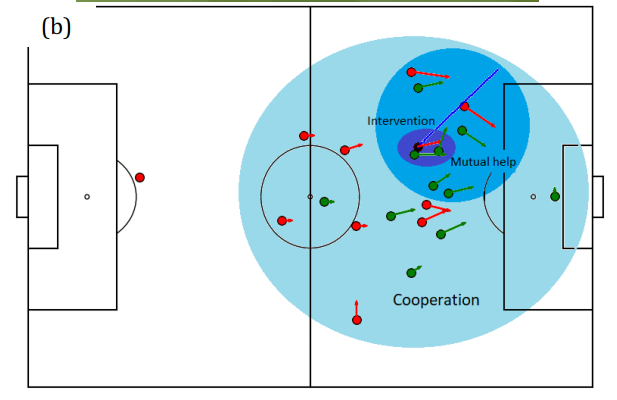Research in Focus: Predicting attacking movement, inspired by Paco Seirul·lo
Francisco Peralta Alguacil, Javier Fernández, Pablo Piñones Arce, David Sumpter, 'Seeing in to the future: using self-propelled particle models to aid player decision-making in soccer'
[Presented at the 2020 MIT Sloan Sports Analytics Conference - link to the paper here]
Why it's worth your time
Firstly, the paper's writers have a history of good work. Secondly, the desire to work out how players position themselves is a fundamental element of football that people in the biz of analytics should be interested in. Thirdly, the approach takes inspiration from studies of animals which investigate how they move as individual beings within a collective unit.
What it says
The paper builds on two pieces of theory. The first is a concept of three zones, coming from Barcelona's long-time coach and current director of methodology Paco Seirul·lo.[1] These zones categorise teammates of the player on the ball. They are the 'intervention zone', an area immediately around the ball; the 'mutual help zone', who could conceivably receive a pass within a few seconds; and the 'cooperation zone', which is kind of everything else. A diagram from the paper is below.
 |
The second idea that the paper uses as a starting point is that players base their positioning based on three factors: pass completion probability (either a pass to themselves or a teammate), impact (dangerous places on the pitch), and pitch control. Each of these can be represented by models built on tracking data.
The idea that the paper aims to test is whether these factors explain player positioning and movement, and whether the influence of the three models differs from between the three zones.
Using tracking data from Swedish team Hammarby's matches, the researchers found that a combination of pass probability and impact was a good predictor of player positioning in the mutual help zone.
In other instances the player's current position was a better predictor of their future position in an attack than any of the models the researchers created. They note: "This result does not imply that standing still is the optimal model for players in the co-operation zone, instead it means that we have not yet identified a model that outperforms the control."
[1] "Seirul·lo's three zones" - the idea of these three zones isn't necessarily exclusive to Seirul·lo, but I'll refer to them as such in absence of any other name for them.
What's cool about it
This paper is a melding of coaching theory and foundational analytics models, something that is great to see. Like in regular science, developing and examining these fundamental ideas of how football works will build a solid base for future work to springboard from.
There's a kind of humility represented in this too. A large part of this paper is about understanding what players already do, rather than just assuming that a data-based model will offer them a better way of doing things.
Happily (for analytics), a section of the paper does focus on using models like pitch control as teaching or feedback tools with players and coaches. A brief example is below:
"The model also suggested that Söderström (13), Andersen (8) and Solheim (77) should all move further up the pitch than they did. The coaches agreed strongly with the model results in this case, and this became a focus for discussions with the full-backs and central midfielders during the season."
'Research in Focus' is like SparkNotes for football analytics: summarising and analysing the best research out there. Get Goalside supporters get access to every post, with a rotating selection free to access for all. Follow this link for the list of all Research in Focus pieces.